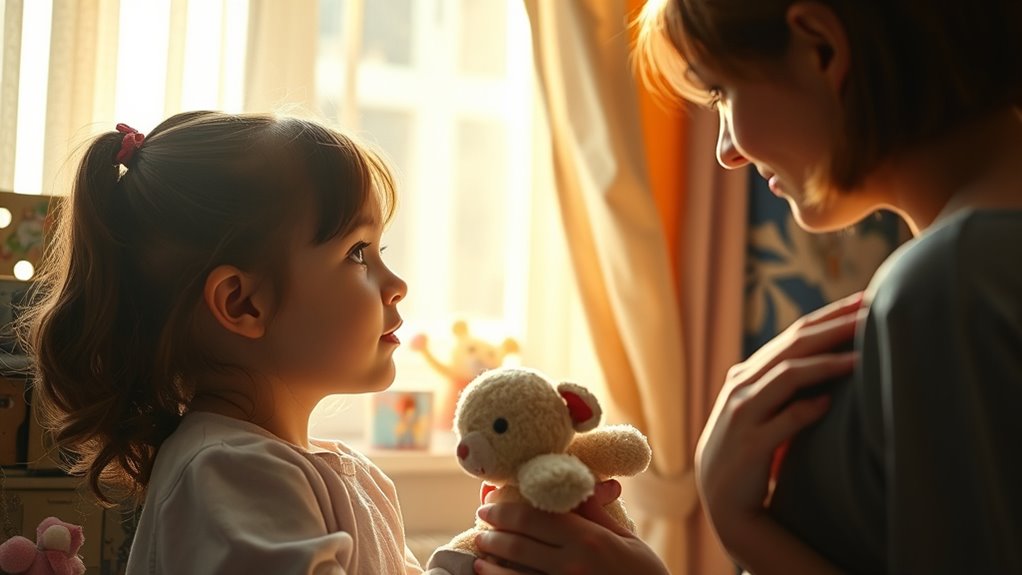To help kids cope with pet loss gracefully, offer a gentle space where they can share memories and express emotions openly. Create comforting rituals like holding a memorial or planting a tree, which provide closure and lasting connection. Listen patiently and validate their feelings, responding with empathy and understanding. Encourage creative outlets like drawing or writing to help process grief. If you keep exploring, you’ll find more ways to support your child’s healing journey.
Key Takeaways
- Encourage children to share memories and feelings to process grief and honor the pet’s significance.
- Create meaningful rituals, like memorials or planting a tree, to provide closure and ongoing comfort.
- Offer a safe space for children to express emotions through drawing, writing, or talking.
- Be patient and compassionate, validating their feelings without rushing healing.
- Support resilience by helping children find ways to remember and celebrate their pet’s life.

Losing a beloved pet can be incredibly hard for kids to understand and process. They often feel overwhelmed by sadness and confusion, unsure of how to handle such a big loss. During these tough times, helping them find ways to express their feelings becomes essential. One effective approach is sharing memories. Sit down with your child and encourage them to talk about their favorite moments with their pet. Maybe they remember a special walk, a funny trick, or a quiet cuddle they shared. As they recount these stories, they begin to see the pet as a beloved member of their life, not just a fading presence. Sharing memories helps children honor their pet’s life and keeps the bond alive in their hearts. It also provides an outlet for their grief, turning raw sadness into something meaningful.
Creating rituals is another powerful way to support children through pet loss. Rituals give children a sense of structure and comfort during a time of upheaval. You might suggest holding a small memorial service, where your child can say goodbye and share their feelings openly. Lighting a candle in memory of the pet, planting a tree, or setting up a special corner with photos and mementos can also serve as ongoing reminders of the pet’s significance. These rituals symbolize that although the pet has gone, their impact remains. They help children understand that mourning is part of healing and that it’s okay to feel sad. Engaging in these activities together allows your kid to see that they’re not alone in their grief and that their feelings are valid. Recognizing the importance of emotional processing can further aid children in their healing journey.
Encouraging your child to participate in sharing memories and creating rituals also teaches them healthy ways to cope. It gives them control over their grief process and helps them develop resilience. Be patient and listen actively, validating their emotions without rushing them to feel better. Remember, everyone processes loss differently, so what comforts one child might not work for another. Some might find solace in talking, while others prefer quiet reflection or creative outlets like drawing or writing. By guiding them through these steps, you’re helping your child navigate their emotions with compassion and understanding. Over time, these shared memories and meaningful rituals can become comforting touchstones, allowing your child to honor their pet’s memory and gradually find peace.
Frequently Asked Questions
How Can I Support My Child’S Grief Without Overwhelming Them?
To support your child’s grief without overwhelming them, listen actively and validate their feelings. You can incorporate cultural rituals that honor their pet, providing comfort and familiarity. Offer creative outlets like drawing or storytelling, helping them express emotions safely. Keep conversations gentle and age-appropriate, and let them process grief at their own pace. Your steady presence and understanding will help them navigate loss while feeling supported and secure.
What Signs Indicate My Child Needs Additional Emotional Support?
Pay close attention to your child’s cues; clues like changing behavior, social withdrawal, and persistent sadness signal they might need extra support. If they suddenly stop sharing or withdraw from friends and activities, it’s a sign they’re struggling. Listen, observe, and offer comfort. When their coping seems to falter or feelings become overwhelming, consider seeking help from a counselor or therapist to guide them through their grief.
How Do I Address Feelings of Guilt My Child May Have?
When your child feels guilt, focus on guilt management by gently explaining that their feelings are normal but that blaming themselves isn’t helpful. Offer emotional reassurance by reminding them that they loved their pet and did their best. Encourage open conversations, listen patiently, and validate their feelings. Help them understand that everyone makes mistakes, and it’s okay to feel sad or guilty—what matters most is healing together.
When Should I Consider Professional Help for My Child’s Grief?
They say, “Better safe than sorry,” so consider professional help if your child’s grief persists or worsens after a few weeks. Watch for signs like withdrawal, trouble sleeping, or intense sadness. You might want to explore therapeutic intervention or grief counseling if their feelings interfere with daily life or if they seem overwhelmed. Seeking help early guarantees your child receives support to process their grief healthily.
How Can I Help My Child Remember Their Pet Positively?
You can help your child remember their pet positively by encouraging memory preservation through creative expressions like drawing, writing stories, or making a scrapbook. Share happy memories together and celebrate the pet’s special qualities. These activities help your child process their feelings while keeping the pet’s memory alive in a meaningful way. Offer support and patience as they explore their emotions and find comfort in these heartfelt remembrance activities.
Conclusion
Losing a pet feels like losing a part of your child’s heart, but with gentle support, they can find comfort and healing. By openly talking, honoring their feelings, and creating lasting memories, you help their grief gradually fade like a sunrise chasing away the night. Remember, your patience and love are the steady anchors guiding them through this storm. Together, you’ll help them see that even in goodbye, there’s a promise of new beginnings ahead.










